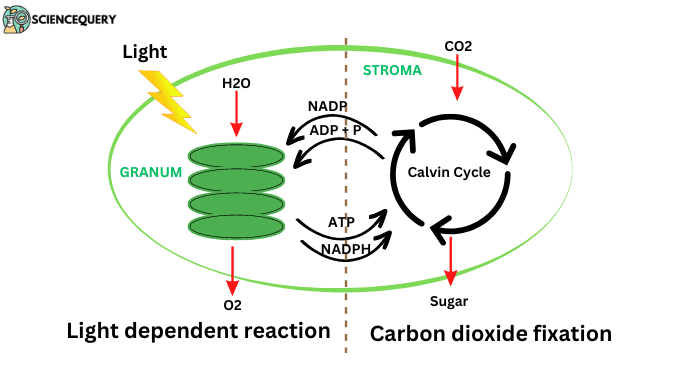
What are the products of light-dependent reactions?
NADPH+H and ATP are products of light-dependent reactions. This energy is used in dark reactions to produce carbohydrates. All photosynthetic animals used NADP+ H as a reducing factor.
In light-dependent reactions, light energy is converted into chemical energy. Chlorophyll and accessory pigments absorb sunlight as photons and produce ATP and NADPH+H and oxygen gas as by-products.
Formation of ATP and NADPH+H
- Firstly chlorophyll absorbs a photon and comes to an excited stage for this reason photolysis of water occurs.
- Photolysis of water occurs in PS-II in the presence of Mn++ and Cl– ions.
- Chlorophyll-a molecule reacts with water molecules in this state PS-II is activated then H2O molecules dissociate into H+ and OH– ions, this reaction is called photolysis of water.
- Electrons are released into OH– ions and at the end H2O molecule is produced and oxygen gas is released. Electrons reduced NADP to NADPH. ADP and ip (inorganic phosphate) produced ATP this reaction is called photophosphorylation.
Overall reactions have two types
1. Non- cyclic photophosphorylation
2. Cyclic photophosphorylation
Non-cyclic photophosphorylation
Definition
It is the transport of electrons in which electrons do not move in the cycle and make end product ATP, NADPH, and oxygen.
- PS-I and PS-II are both photosystems that participate in noncyclic photophosphorylation, this process is also called z-scheme.
- In there NADP is reduced into NADPH2 by ferredoxin NADP reductase.
- Photolysis of water and evolution of oxygen takes place.
- In noncyclic photophosphorylation 1 ATP and 2 NADPH2 molecules are produced.
Cyclic photophosphorylation
Definition
It is a pathway in which photoexcited electrons come back to the chlorophyll and make ATP molecules.
- In this reaction, only PS-I participates. The electron expelled from P700 chlorophyll-a molecules is cycled back into P700 hence this reaction is called cyclic electron transport and this photophosphorylation is called cyclic photophosphorylation.
- In there 2ATP molecules are produced.
- Cyclic pathways take place when the activity of PS- II is blocked for some reason and when the intensity of light is low.
Written By: Richa Pachori
